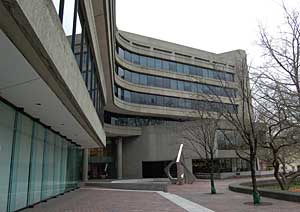In 1973, the American Institute of Architects (AIA) moved into its 180,000-square-foot headquarters on New York Avenue, near the White House. The Modernist building was designed by The Architects Collaborative, a firm that counted Walter Gropius among its founders.

Now, more than three decades later, the aging concrete building is slated to undergo its first comprehensive renovation. “The building is 35 years old and it is becoming increasingly difficult to keep the systems operational,” explains James Gatsch, FAIA, who is serving as the owner’s rep for the project. Given that the building might be eligible for the National Register of Historic Places in the future, the project won¹t entail a dramatic facelift. Instead, it calls for modifications that will make the building more energy efficient, such as new operable, double-paned windows and an interior reconfiguration that allows for increased natural ventilation. Gatsch says they also plan to slightly shrink the first floor to reinstate the building’s original footprint, which was enlarged by an expansion years ago.
The AIA has dubbed the undertaking the “21st Century Workplace Project.” By employing sustainable strategies and integrated project delivery methods, the project could offer a glimpse into the future of architectural practice. “The AIA believes the right way to renovate the building is to do it in a green way, and to use it as a demonstration project for how to renovate mid-century, urban office buildings, of which there is a significant stock of across the country,” Gastch explains.
The project began with a request for qualification statements sent out to the AIA’s nearly 80,000 members; 24 firms threw their names in the hat. After reviewing the statements, a jury interviewed short-listed candidates and in December 2007, selected Washington, D.C.-based Studios Architecture for the job. DPR Construction—ranked the fifth “greenest” contractor by Engineering News-Record in 2007—was hired to serve as general contractor in March, and Syska and Hennessey were signed as engineers the following month. In keeping with the AIA’s goal to develop talent and increase diversity in the profession, it plans to award 15 percent of all subcontracting work to young firms, and 15 percent to women- and minority-owned firms.
Using BIM, the team hopes to be able to test all ideas quickly and deeply. “The BIM model allows us to look at how all systems interact without clashing,” explains Studios chief Todd DeGarmo, FAIA. “With the software, lighting and AV are all worked out ahead of time rather than getting tested in the field. And when you get to construction documents, your contractors don't have to order 10 percent more of everything.” The project team is also using the new, integrated project delivery legal documents that were published in May. “We believe that we’re kind of out in front of everybody in using these documents,” Gatsch says.
While it’s still too early to pinpoint the project’s green strategies, the team hopes to make the AIA headquarters a standard-bearer of sustainable design. The goal is to reduce energy use by 60 percent, Gatsch says, and create a space that enjoys abundant daylight and natural ventilation.
Currently, the team is nearing completion of detail design. Once construction gets under way, the AIA plans to set up a Web cam at the site to allow members to view the progress. It also will create a special section about the project on the AIA Web site. While Gatsch predicts there will be kinks in the design process, he sees this project as a chance to showcase "new ways of contracting, maintaining relations with the communities, and being an example of renovating in sustainable ways."
Jenna M. McKnight contributed additional reporting for this story.





Post a comment to this article
Report Abusive Comment